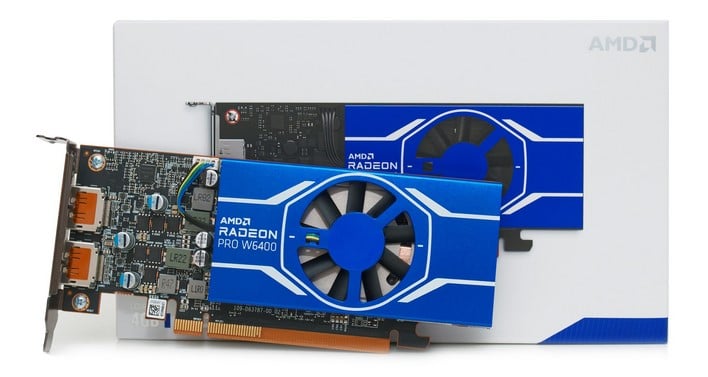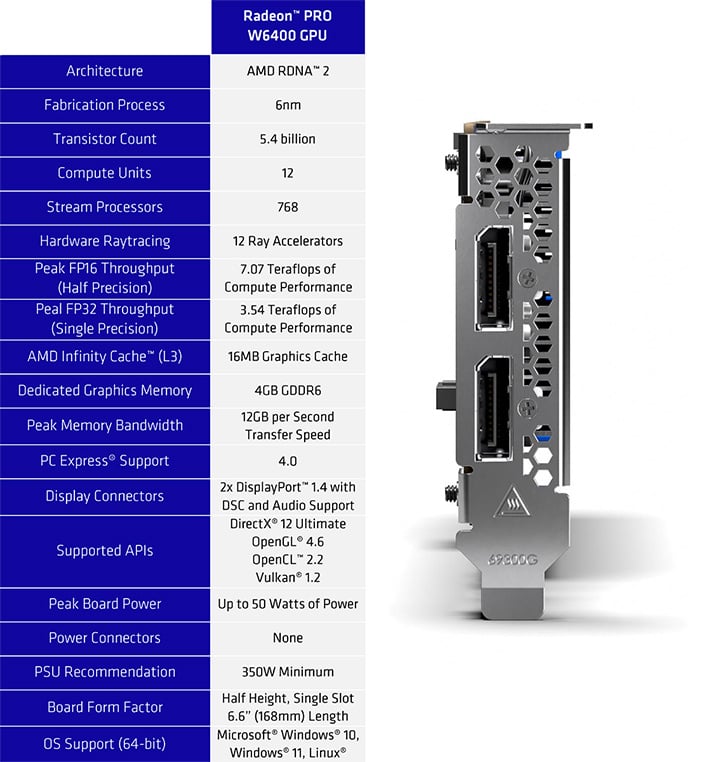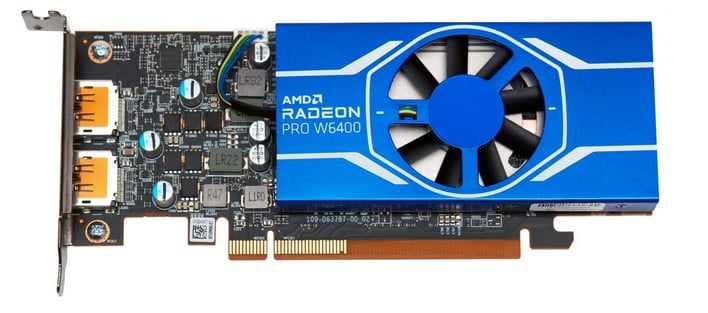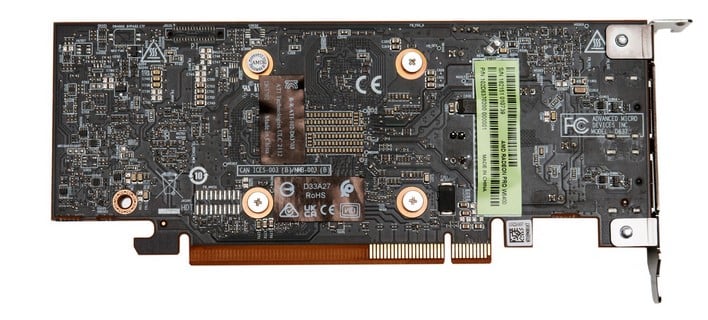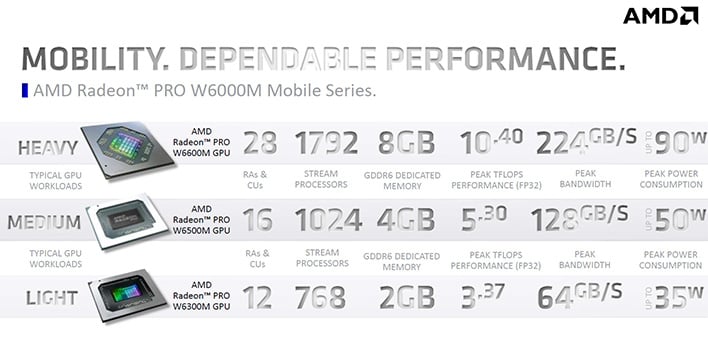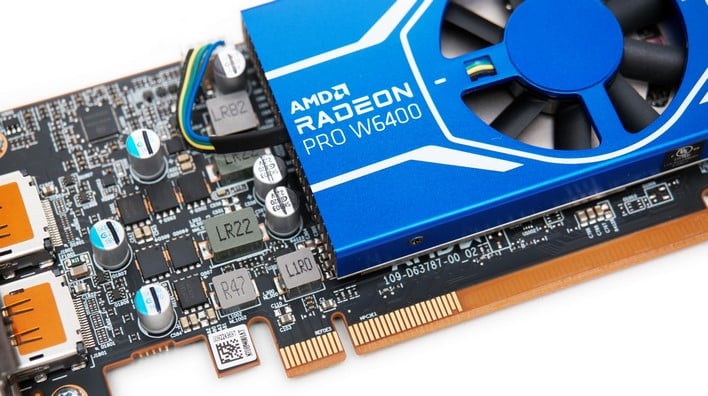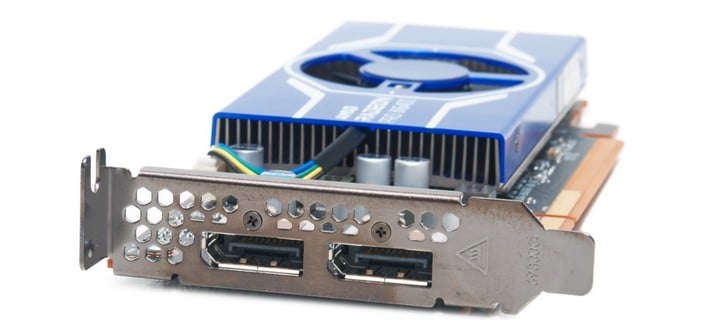AMD Radeon Pro W6400 Review: Low Power RDNA 2 For Budget Workstations
AMD Radeon Pro W6400: Small Form Factor Navi 24 For Professionals
A couple of weeks back, AMD launched the Radeon RX 6500 XT, an entry-level GPU targeting mainstream gamers with 1080p displays. The Radeon RX 6500 XT is built around the Navi 24 GPU, which is the smallest discrete graphics processor in AMD’s current RDNA 2 line-up. Navi 24 is manufactured on a 6nm process node, and is comprised of roughly 5.4B transistors, with 16MB of AMD Infinity Cache, and a die size of only 107mm2. That's a tiny piece of silicon, compared to modern, higher-end GPUs. In addition to launching a mainstream gaming GPU, however, AMD also put Navi 24 to work in a freshly-baked Radeon Pro for the workstations market, the aptly named Radeon Pro W6400.
The Radeon Pro W6400 we’ll be showing you here today takes Navi 24 and scales things back even further, to a miniscule half-height add-in card that doesn’t need any supplemental power – it gets all of its juice directly from its PCIe slot. In addition to the small form factor though, there are some other special considerations to make with this card as well. But before we get ahead of ourselves, let’s check out the main features and specifications and take a tour of the card...
AMD Radeon Pro W6400 Features & Specifications
Whereas the full implementation of Navi 24 features 16 Compute Units (CUs) with 16 Ray Accelerators (one per CU), and a total of 1024 Stream Processors, Navi 24 as it is implemented on the Radeon Pro W6400 features only 12 CUs (with 12 Ray Accelerators), for a grand total of 768 Stream Processors. In this configuration, the Radeon Pro W6400 offers up to 7.07TFLOPs of FP16 compute performance and FP32 clocks in at 3.54TFLOPs, when the card is operating at default frequencies.
The GPU is linked to a 4GB of GDDR6 memory, operating at an effective data rate of 12Gbps (6GHz) over a narrow 64-bit interface, which offers up to 96GB/s of raw peak bandwidth, or up to 231GB/s if you factor in the effective increase afforded by the high-bandwidth, low-latency Infiniti Cache. The Radeon Pro W6400 features only a PCIe Gen 4 x4 interface to the host system, and just like the Radeon RX 6500 XT, the Radeon Pro W6400 lacks any sort of dedicated video encode acceleration.
Everything about the Radeon Pro W6400 screams low-power, which is reflected in its peak board power of only 50 Watts. As such, the Radeon Pro W6400 doesn’t require a supplemental power feed or a beefy power supply. AMD calls for only a 350W PSU, which should make the W6400 suitable for a wide range of small form factor and compact desktop systems. Incidentally, the low-power nature of the Navi 24 GPU also makes it suitable for mobile systems. In fact, AMD has a pair of mobile configurations in the pipeline, namely the Radeon Pro W6300M and W6500M.
Due to the lack of hardware accelerated video encode on the GPU, Navi 24 arguably makes more sense in mobile applications. Should the dGPU be paired with a processor that has an iGPU with a dedicated media encode engine, one of Navi 24's drawbacks would be mitigated.
The card itself uses the now-familiar YInMn Blue on its fan shroud, common to all Radeon Pros. As you can see, the Radeon Pro W6400 is a tiny HHHL card that takes up only a single slot and there are no frills front or back. If you pay close attention, you’ll also notice the dearth of contacts on the card edge; because the Radeon Pro W6400 has a PCIe Gen 4 x 4 interface, contacts that run the length of the PCIe x16 sized card edge are simply not needed.
That also means that the Radeon Pro W6400 is best suited to modern platforms that support PCIe Gen 4. Installing this card as an upgrade in a PCIe Gen 3-enabled system will cut slot bandwidth in half and limit performance in some applications.
In terms of its outputs, AMD equips the Radeon Pro W6400 with only a pair of full-sized DisplayPorts (DP 1.4 with DSC and Audio support). AMD’s market research found that the vast majority of customers for a card of this type use only one or two displays and they prefer full-sized ports to eliminate the need for any sort of dongle. We should also note that AMD will be including both full- and half-height case brackets with the Radeon Pro W6400, to cover installation in virtually any type of system.
The Radeon Pro W6400 we’ll be showing you here today takes Navi 24 and scales things back even further, to a miniscule half-height add-in card that doesn’t need any supplemental power – it gets all of its juice directly from its PCIe slot. In addition to the small form factor though, there are some other special considerations to make with this card as well. But before we get ahead of ourselves, let’s check out the main features and specifications and take a tour of the card...
AMD Radeon Pro W6400 Features & Specifications
Whereas the full implementation of Navi 24 features 16 Compute Units (CUs) with 16 Ray Accelerators (one per CU), and a total of 1024 Stream Processors, Navi 24 as it is implemented on the Radeon Pro W6400 features only 12 CUs (with 12 Ray Accelerators), for a grand total of 768 Stream Processors. In this configuration, the Radeon Pro W6400 offers up to 7.07TFLOPs of FP16 compute performance and FP32 clocks in at 3.54TFLOPs, when the card is operating at default frequencies.
The GPU is linked to a 4GB of GDDR6 memory, operating at an effective data rate of 12Gbps (6GHz) over a narrow 64-bit interface, which offers up to 96GB/s of raw peak bandwidth, or up to 231GB/s if you factor in the effective increase afforded by the high-bandwidth, low-latency Infiniti Cache. The Radeon Pro W6400 features only a PCIe Gen 4 x4 interface to the host system, and just like the Radeon RX 6500 XT, the Radeon Pro W6400 lacks any sort of dedicated video encode acceleration.
Everything about the Radeon Pro W6400 screams low-power, which is reflected in its peak board power of only 50 Watts. As such, the Radeon Pro W6400 doesn’t require a supplemental power feed or a beefy power supply. AMD calls for only a 350W PSU, which should make the W6400 suitable for a wide range of small form factor and compact desktop systems. Incidentally, the low-power nature of the Navi 24 GPU also makes it suitable for mobile systems. In fact, AMD has a pair of mobile configurations in the pipeline, namely the Radeon Pro W6300M and W6500M.
The card itself uses the now-familiar YInMn Blue on its fan shroud, common to all Radeon Pros. As you can see, the Radeon Pro W6400 is a tiny HHHL card that takes up only a single slot and there are no frills front or back. If you pay close attention, you’ll also notice the dearth of contacts on the card edge; because the Radeon Pro W6400 has a PCIe Gen 4 x 4 interface, contacts that run the length of the PCIe x16 sized card edge are simply not needed.
That also means that the Radeon Pro W6400 is best suited to modern platforms that support PCIe Gen 4. Installing this card as an upgrade in a PCIe Gen 3-enabled system will cut slot bandwidth in half and limit performance in some applications.
In terms of its outputs, AMD equips the Radeon Pro W6400 with only a pair of full-sized DisplayPorts (DP 1.4 with DSC and Audio support). AMD’s market research found that the vast majority of customers for a card of this type use only one or two displays and they prefer full-sized ports to eliminate the need for any sort of dongle. We should also note that AMD will be including both full- and half-height case brackets with the Radeon Pro W6400, to cover installation in virtually any type of system.

